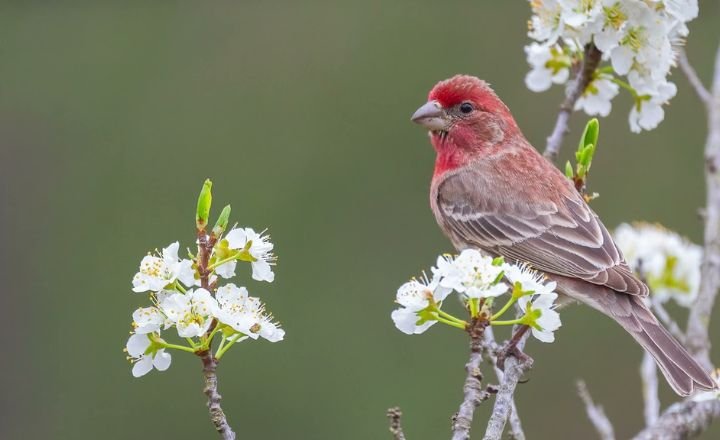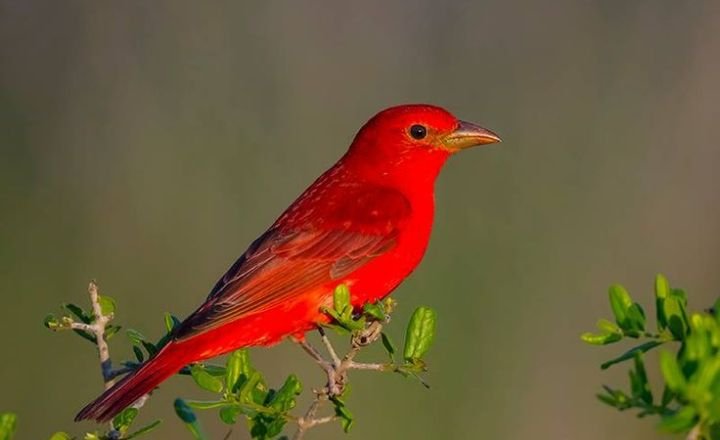Birds with Redheads are woodpeckers with their flaming crests to other captivating species, these avian wonders more than just aesthetic beauty. Their alluring appearances but also their fascinating behavioral and ecological objectives.
11 different kinds of birds with red heads These eye-catching creatures not only captivate us with their looks but also fulfill important ecological roles. The range of red-headed birds, focusing on their charming behaviors and significance.
Types of birds with redheads
Types of birds with red head, the vibrant hues of their plumage can’t help but catch your eye. The Northern Cardinal, for instance. Texas, red birds command attention not just for their striking plumage but also for their remarkable behaviors. Among the most notable are the Northern Cardinal and the Red-headed Woodpecker.
House Finch
The House Finch is a bird that has a unique blend of adaptability and charm, making it a sight across North America. Its striking striped plumage and the males sporting vivid red accents during mating season, a splash of color to urban landscapes and gardens. Their physical beauty, red head birds exhibit intriguing social dynamics.

Their diet consists of fruits, nuts, seeds, and various vegetation, which they cleverly scavenge from backyards and parks. Their communication skills extend mere mimicry; they have a complex social structure that relies on distinct calls and songs to convey messages about territory, mating.
A group of House Finches interacting is like a mini-drama unfolding their cognitive abilities. House Finch eggs are truly a marvel of nature, an array of colors that can leave you in awe. These eggs are a lovely blue or greenish hue, dotted with speckles that resemble tiny works of art.
Downy Woodpecker
The Downy Woodpecker, a little bird that flits about North American forests, is a charming sight for nature lovers and casual observers. Measuring only about 5.5 to 6.7 inches, this pint-sized avian features a striking black and white plumage that makes it easily the greenery of parks and suburban areas.
Their diet of insects, insect larvae, seeds, and berries, making them pest controllers in gardens and forests. During mating season, Downy Woodpeckers form monogamous pairs and work together to create cozy nests in tree cavities, a teamwork dynamic that’s truly endearing.
The female Downy Woodpecker, often overshadowed by her more male counterpart, boasts a charm that’s all her own. She lacks the bold red patch atop the male’s head, her subtle beauty lies in her delicate black and white plumage.
Red-bellied Woodpecker
The Red-bellied Woodpecker is a delightful gem in North America’s avian tapestry. Its red cap and striking black-and-white plumage, this small bird, measuring 5.5 to 6.7 inches, can easily flit through woodlands and suburban backyards.

A tree trunk, using its sharp beak to expertly chisel away at the bark in search of insects and larvae, or even enjoying a snack of seeds and berries. These birds form strong bonds with their partners, working together to build cozy nests in tree hollows an act their commitment to family life.
During mating season can be quite a treat; their calls fill the air as they communicate with each other, establishing territories and strengthening their pair bond. The female Red-bellied Woodpecker with her soft gray plumage and subtle hints of rosy red on her belly, embodies a beauty that’s easy to overlook at first glance.
Hairy Woodpecker
The Hairy Woodpecker is a true marvel of the woodlands, blending into its surroundings with striking black and white plumage. These small to medium-sized birds, measuring around 7 to 10 inches, are often overshadowed by their flashier relatives but possess an undeniable charm.
The males sport a red patch on the back of their heads, adding a dash of color to their otherwise monochromatic appearance. Their diet is a delightful mix, seeds and berries to complement their insect feast. Their sharp “peek” or “pik” sounds echoing through the trees, of their presence even they’re hidden from view.
The Hairy Woodpecker, with its striking black-and-white plumage and distinctive drumming, thrives in a variety of habitats that reveal the complexity of forest ecosystems. These birds in mature forests, they favor deciduous trees like oaks and maples.
Summer Tanager
The Summer Tanager is a vibrant color that graces our woodlands during the warmer months, transforming the landscape with its striking presence. Males flaunt a brilliant red plumage that stands out against the lush green backdrop, while females showcase a more subtle yellow to olive-green hue.

This small to medium-sized songbird, measuring about 6.3 — 7.5 inches in length, adds a cheerful touch to any forest or shaded area, making it a delightful sight for birdwatchers and nature lovers. Its calls resonate like a sweet symphony, the trees .They play role in the ecosystem by feasting primarily on insects, including bees and wasps, helping to maintain a balance in their habitats.
Red-Headed Woodpecker
The Acorn Woodpecker is a delight, boasting a brilliant red head that demands attention against its pristine white body. Black wings that really set this medium-sized woodpecker apart from its avian peers. Measuring between 7.5 to 9.8 inches, it strikes a perfect balance of size and presence, making it a favorite among bird watchers.
It has a diet that includes insects, nuts, fruits, and even the occasional snack from dead trees or wooden structures. The Acorn Woodpecker their unique behavior of storing these nuts in tree trunks showcases their intelligence and resourcefulness. As they are vocal with a variety of calls, including their distinctive “wick-a-wick.”
Northern Cardinal
With their crest and charming songs, these medium-sized songbirds, measuring about 8–9 inches, are often spotted flitting between branches or perched in gardens and parks. Their vivid colors stand out against the green backdrop of woodlands, making them a favorite among birdwatchers and nature.

Northern Cardinals are omnivorous, enjoying a varied menu that includes seeds, insects, and fruits. This dietary flexibility is a testament to their resilience in different environments. When it comes to nesting, they prefer to build cozy up-shaped nests in shrubs and trees, using twigs, grass, and leaves creating a snug sanctuary for their young.
Pileated Woodpecker
The Pileated Woodpecker is a true marvel of the avian world, boasting a striking red crest that can’t help but catch your eye. This bird, standing out against the backdrop of lush forests and wooded areas, thrives among towering trees. A bird with a red head can instantly capture the attention of any nature enthusiast.
Measuring an impressive 16 to 19 inches in length, its size alone commands attention, making it one of North America’s largest woodpeckers. It flits from tree to tree, using its powerful beak to excavate deep cavities in search of insects or hidden treasures like fruits and nuts.
The Pileated Woodpecker’s distinctive “yak-yak-yak” call echoing through the woods, a sound that adds character to the serene forest atmosphere. Nesting in large tree cavities, these woodpeckers not only create homes for themselves but also contribute to the ecosystem by providing nesting sites for other species.
Pine Grosbeak
The Pine Grosbeak, a medium-sized finch, graces the colder regions of North America and Eurasia with its vibrant presence. Measuring about 7.9 to 10.2 inches in length, this bird sports dark wings and tails that contrast beautifully with its rosy plumage. The evergreen trees, their love for pine wood becomes evident, as they feast on the seeds of conifer cones.

These birds navigate their frosty habitats like witnessing a charming winter ballet, each movement reflects their adaptability and resilience. Their diet is made up of seeds and berries, and gather in flocks when food is plentiful.
Purple Finch
Small to medium-sized, these finches measure about 5 to 6 inches long, making them perfect for flitting through gardens and woodland edges. Raspberry and brown, giving them a unique look that’s hard to miss. Their colors that charm birdwatchers; it’s their lively behavior, they’re feeding on seeds, buds, fruits, and even the insect.
When breeding season rolls around, the Purple Finch truly shines with its melodious songs. Males potential mates with a sweet that fills the air, a lovely soundtrack to the warmer months. Their nesting habits are equally: they build cup-shaped nests in trees and shrubs, carefully weaving twigs and grasses to create cozy homes for their young.
Acorn Woodpecker
The Acorn Woodpecker in the avian world, for those lucky enough to spot one in North and Central America. Measuring about 8–9.5 inches (20–24 cm) long, these birds boast a striking black and white plumage that makes them stand out against the backdrop of lush forests. Red headed birds presents a different equally captivating narrative.
Their unique “granaries,” Acorn Woodpeckers are like little architects, storing acorns in tree trunks, creating a veritable pantry in nature. Their distinctive “waka-waka” sounds echo through the woods, serving as both a communication tool and a territorial call.
Conclusion
The world of birds with red heads is as fascinating as it is diverse. The striking Northern Cardinal to the vibrant Red-headed Woodpecker, each species brings its own unique flair to our skies and backyards.
11 Different kinds of Birds with Red Heads not only add color to our lives but also connect us to nature in a meaningful way. An avid birdwatcher or simply enjoy the beauty of nature, these red-headed wonders are sure to capture your attention.
FAQs
What kind of bird has a red head?
Common species include the Red-headed Woodpecker, Northern Cardinal, and the Red-breasted Merganser.
What kind of bird has a red head in Ontario?
Common birds with red heads in Ontario include the Red-headed Woodpecker, the Northern Cardinal, and the Common Redpoll.
What British birds have a red head?
Common British birds with red heads include the European Robin, the Great Spotted Woodpecker, and the Red-headed Bunting.
